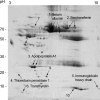Identification of new proteins in follicular fluid from mature human follicles by direct sample rehydration method of two-dimensional polyacrylamide gel electrophoresis
- PMID: 15953869
- PMCID: PMC2782203
- DOI: 10.3346/jkms.2005.20.3.456
Identification of new proteins in follicular fluid from mature human follicles by direct sample rehydration method of two-dimensional polyacrylamide gel electrophoresis
Abstract
Human follicular fluid (HFF) includes various biologically active proteins which can affect follicle growth and oocyte fertilization. Thus far, these proteins from mature follicles in human follicular fluid have been poorly characterized. Here, two-dimensional polyacrylamide gel electrophoresis (2-DE) with matrix-assisted laser desorption/ionization-mass spectrometry (MALDI-MS) was used to identify new proteins in HFF. Mature follicular fluids were obtained from five females after oocyte collection during in vitro fertilization (IVF). We directly rehydrated HFF samples, obtained high-resolution 2-DE maps, and processed them for 2-DE and MALDI-MS. One hundred eighty spots were detected and 10 of these spots were identified. By the 2-DE database, six of them had been reported, as proteins already existing in HFF. Hormone sensitive lipase (HSL), Unnamed protein product 1 (UPP1), Unnamed protein product 2 (UPP2), and apolipoprotein A-IV precursor were newly detected. HSL and apolipoprotein A-IV participate in lipid metabolism. UPP1 has a homology with selenocysteine lyase. We found by RT-PCR that these genes are expressed from human primary granulosa cells. The proteins identified here may emerge as potential candidates for specific functions during folliculogenesis, hormone secretion regulation, or oocyte maturation. Further functional analysis of these proteins is necessitated to determine their biological implications.
Figures


Similar articles
-
Identification of new proteins in follicular fluid of mature human follicles.Electrophoresis. 2002 Apr;23(7-8):1197-202. doi: 10.1002/1522-2683(200204)23:7/8<1197::AID-ELPS1197>3.0.CO;2-2. Electrophoresis. 2002. PMID: 11981869
-
[Proteomics of follicular fluid in mature human follicles and antral follicles: a comparative study with laser desorption/ionization-time of flight-mass spectrometry].Nan Fang Yi Ke Da Xue Xue Bao. 2008 Feb;28(2):275-8. Nan Fang Yi Ke Da Xue Xue Bao. 2008. PMID: 18250062 Chinese.
-
Specific peptide patterns of follicular fluids at different growth stages analyzed by matrix-assisted laser desorption/ionization time-of-flight mass spectrometry.Biochim Biophys Acta. 2007 Jan;1770(1):29-38. doi: 10.1016/j.bbagen.2006.06.017. Epub 2006 Jul 21. Biochim Biophys Acta. 2007. PMID: 16949757
-
Proteomic analysis of recurrent spontaneous abortion: Identification of an inadequately expressed set of proteins in human follicular fluid.Proteomics. 2006 Jun;6(11):3445-54. doi: 10.1002/pmic.200500775. Proteomics. 2006. PMID: 16637005
-
Protein pathways working in human follicular fluid: the future for tailored IVF?Expert Rev Mol Med. 2016 May 6;18:e9. doi: 10.1017/erm.2016.4. Expert Rev Mol Med. 2016. PMID: 27149979 Review.
Cited by
-
Peptidomic analysis of follicular fluid in patients with polycystic ovarian syndrome.Front Cell Dev Biol. 2023 Nov 8;11:1289063. doi: 10.3389/fcell.2023.1289063. eCollection 2023. Front Cell Dev Biol. 2023. PMID: 38020909 Free PMC article.
-
Downregulated expression of peroxiredoxin 4 in granulosa cells from polycystic ovary syndrome.PLoS One. 2013 Oct 3;8(10):e76460. doi: 10.1371/journal.pone.0076460. eCollection 2013. PLoS One. 2013. PMID: 24098506 Free PMC article.
-
A proteomic analysis of human follicular fluid: comparison between younger and older women with normal FSH levels.Int J Mol Sci. 2014 Sep 29;15(10):17518-40. doi: 10.3390/ijms151017518. Int J Mol Sci. 2014. PMID: 25268621 Free PMC article.
-
N-glycoproteomic analysis of human follicular fluid during natural and stimulated cycles in patients undergoing in vitro fertilization.Clin Exp Reprod Med. 2017 Jun;44(2):63-72. doi: 10.5653/cerm.2017.44.2.63. Epub 2017 Jun 30. Clin Exp Reprod Med. 2017. PMID: 28795044 Free PMC article.
-
Proteomic analysis of human follicular fluid from fertile women.Clin Proteomics. 2015 Mar 3;12(1):5. doi: 10.1186/s12014-015-9077-6. eCollection 2015. Clin Proteomics. 2015. PMID: 25838815 Free PMC article.
References
-
- Nayudu PL, Lopata A, Jones GM, Gook DA, Bourne HM, Sheather SJ, Brown TC, Johnston WI. An analysis of human oocytes and follicles from stimulated cycles: oocyte morphology and associated follicular fluid characteristics. Hum Reprod. 1989;4:558–567. - PubMed
-
- Kawano Y, Fukuda J, Nasu K, Nishida M, Narahara H, Miyakawa I. Production of macrophage inflammatory protein-α in human follicular fulid and culture egranulosa cells. Fertil Steril. 2004;82:1206–1211. - PubMed
-
- Ocal P, Aydin S, Cepni I, Idil S, Idil M, Uzun H, Benian A. Follicular fluid concentrations of vascular endothelial growth factor, inhibin A and inhibin B in IVF cycles: are they markers for ovarian response and pregnancy outcome? Eur J Obstet Gynecol Reprod Biol. 2004;115:194–199. - PubMed
-
- Cunha-Filho JS, Lemos NA, Freitas FM, Kiefer K, Faller M, Passos EP. Insulin-like growth factor (IGF)-1 and IGF binding protein-1 and -3 in the follicular fluid of infertile patients with endometriosis. Hum Reprod. 2003;18:423–428. - PubMed
-
- Hong SJ, Tse JY, Ho PC, Yeung WS. Cumulus cells reduce the spermatozoa-zona binding inhibitory activity of human follicular fluid. Fertil Steril. 2003;79:802–807. - PubMed
Publication types
MeSH terms
Substances
LinkOut - more resources
Full Text Sources

